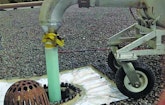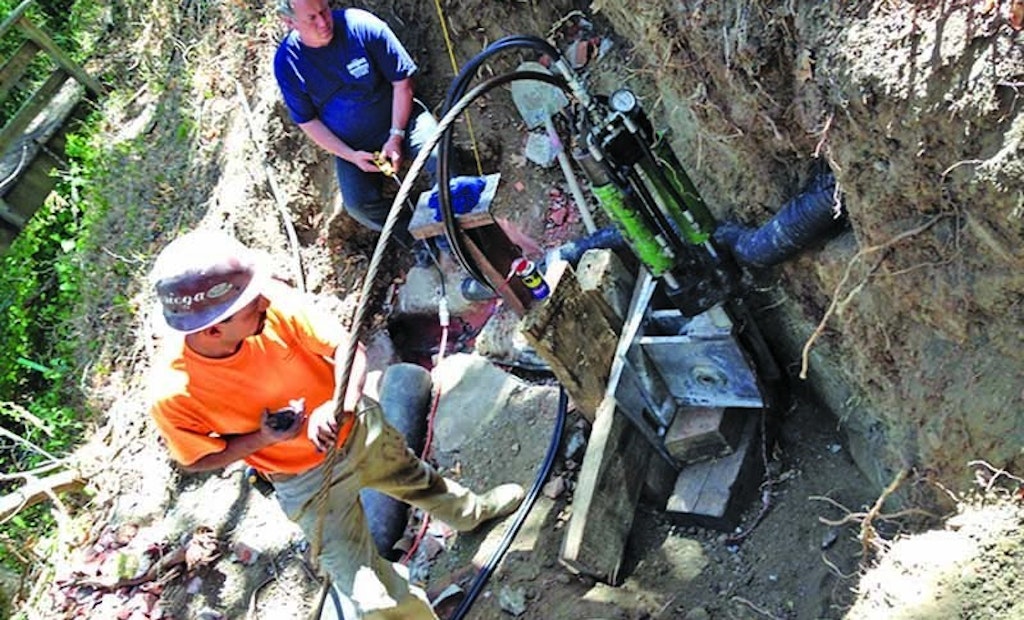Interested in Manholes?
Get Manholes articles, news and videos right in your inbox! Sign up now.
Manholes + Get AlertsLarge culvert rehabilitation project saves money and maintains traffic flow
Problem: An annual inspection in Grottoes, Virginia, uncovered serious problems with the town’s stormwater system. A large set of elliptical CMP culverts did not pass inspection. There was severe corrosion, and individual sections were failing and misaligned. The town’s consultants recommended replacement. Complicating the issue, the failing pipes were four parallel culverts that were all quite large — 70 by 44 inches — running directly underneath Dogwood Avenue, one of Grottoes’ two main thoroughfares.
Solution: The town initially obtained cost estimates for replacing the culverts. The price was high and the plan called for significant and lengthy traffic disruptions. Fortunately, Grottoes Town Manager Jeff Nicely had seen a process called CentriPipe at a Rural Water Association conference and thought it could be useful in this situation. The process is based on spincasting technology developed by AP/M Permaform. The spincaster is pulled back through failing pipes while spraying strong, highly adhesive, fiber-reinforced cementitious grout onto the pipe in thin layers. As the layers build up, they form a new, structurally sound concrete pipe within the old pipe. Sewer flow capacity is minimally affected and no annular space is left between the old and new pipes.
Result: CentriPipe provided a trenchless solution that was 15 percent less expensive than open-cut replacement and provided significant benefits by eliminating the hassles of traffic disruption. The new culverts are smooth, seamless, watertight and structurally strong, with a long projected service life. 800/662-6465; www.centripipe.com.
Contractor uses CIPP to repair leaky Pentagon roof drain
Problem: U.S. government building maintenance personnel from the Pentagon in Washington, D.C., were dealing with a cast iron roof drainpipe that was leaking into the ceiling below whenever it rained or snow melted. The roof drain was a 3-inch vertical line and included three 90-degree fittings in the first 7 feet. Replacement was not an option due to the cost and disruption to occupied office spaces in the Pentagon.
Solution: Using Flow-Liner Systems technology, a certified installer prepared and installed the Flow-Liner Cured-In-Place Pipe Lining System using a specialized procedure. The drainline was successfully lined in one day without excavation or disruption to the occupied office spaces.
Result: The Pentagon’s services coordinator, B3 Enterprises, was pleased with the results, commenting that the pipe lining crew was very professional and courteous. The lining saved Pentagon personnel from having to dig up and replace the piping, which would have been costly and inconvenient. 800/348-0020; www.flow-liner.com.
Lateral lining system used to repair collapsed drain
Problem: A warehouse facility housing three businesses in San Diego, had a problem. The 4-inch common sewer drain buried under the floor of the warehouse was collapsing, and one section had already collapsed. Multiple contractors recommended cleaning 960 feet of pipe and replacing the remaining 140 feet of collapsed pipe.
Solution: The owner didn’t like that solution and asked Brink Services to look at the situation and see if it could solve the problem without disrupting day-to-day operations of the warehouse. The bottom was missing on the entire length of the 1,100-foot cast iron pipe, but it was still round except for the collapsed section. There was a lack of access points, with the shortest line segment being 70 feet, then 289, 141, 140, 220 and 240 feet. Brink Services determined it could employ the Quik Shot lateral lining inversion system from Quik-Lining Systems to make the long lengths between pits, with a 240-foot blind installation at the end. Epoxy resin was chosen to eliminate toxic fumes, and a 60-minute resin hardener was chosen to expedite the project.
Result: The project was completed with no issues, on budget and faster than anticipated. The warehouse was able to continue operations uninterrupted. 605/695-6778; www.quiklining.com.
Pipeline rehabilitated in residential driveway results in cost and time savings
Problem: A 6-inch vitrified clay pipeline in Carrollton, Texas, had significant damage, causing heavy inflow and infiltration. The pipeline was buried 10 feet deep in an alleyway and through a resident’s driveway. Open-cut replacement would cost between $10,000 and $12,000, require at least three days of labor, and the alley would need to be closed during the repair. In addition to the expense to the city, it would be an inconvenience to the homeowner and neighborhood.
Solution: Hoping to avoid an expensive and time-consuming excavation, the city turned to Source One Environmental to provide a trenchless pipe rehabilitation solution. Rehabilitating the pipeline with a CIPP method would restore the pipeline’s structural integrity and improve the overall performance, at a fraction of the cost and time. The company installed the PipePatch point repair system 10 feet deep to cure the 6-inch broken pipeline.
Result: PipePatch eliminated the need for digging by creating a pipe within a pipe with minimal change to the original diameter, improving the overall flow capacity. The repair was significantly less expensive than the original estimate and took less than three hours to complete. Not only was the residential area virtually undisturbed, the rehabilitation added decades of additional service life to the pipeline, ensuring that the residents would not encounter this again. 877/450-3701; www.s1eonline.com.
Small pneumatic head assists in tricky pipe bursting project
Problem: General contractor Bay Pacific Pipelines, working on the Central Contra Costa Sanitary District’s sanitary sewer overflow rehabilitation program, discovered that steeply sloping pipeline runs prevent typical pneumatic pipe bursting methods. One East Bay portion ran 200 feet from a manhole on a hillside to the roadway below. The job called for upsizing 6-inch vitrified clay pipe to 8-inch SDR17 HDPE. Without ready access at either end, the hammer unit was too long to negotiate entry. With the winch unable to be situated on the hill, the upgrade pull option was also eliminated.
Solution: Bay Pacific leased an M50 pipe bursting system (usually for easements and laterals) from TRIC Tools, which it situated behind the manhole base. Removing the manhole cylinder stack, it stabilized the M50 pulling unit by driving an I-beam into the ground and placing heavy timbers against the manhole base. A TRIC Unified Force bursting head was brought in. The UF head employs a small (4-inch-diameter), light, faster-acting hammer, along with far greater cable tension than that of constant-tension winches used with larger pneumatic moles. The smaller hammer releases the stored energy of a much larger cable under load, while the UF head is considerably lighter and more maneuverable than larger counterparts. The 350 cfm air compressor on site had to be throttled down, since the UF hammer requires only 75 cfm at 100 psi to operate efficiently. At the manhole, the M50 maintained optimal cable tension, powered by a TRIC Hi-Flow 14/7 gpm, 5,000 psi hydraulic pump. The UF head and new pipe slid beneath stabilizing road plates up the embankment.
Result: The crew pulled at an average 25 tons of tension — just half the capacity of the M50 — letting the rapid-fire hammer catch up to the load. The pull stayed in the 20- to 30-ton range while remaining on track within the 6-inch-diameter pipe path. At an average rate of 5 feet per minute, total bursting time was well under an hour. 510/865-8742; www.trictools.com.










